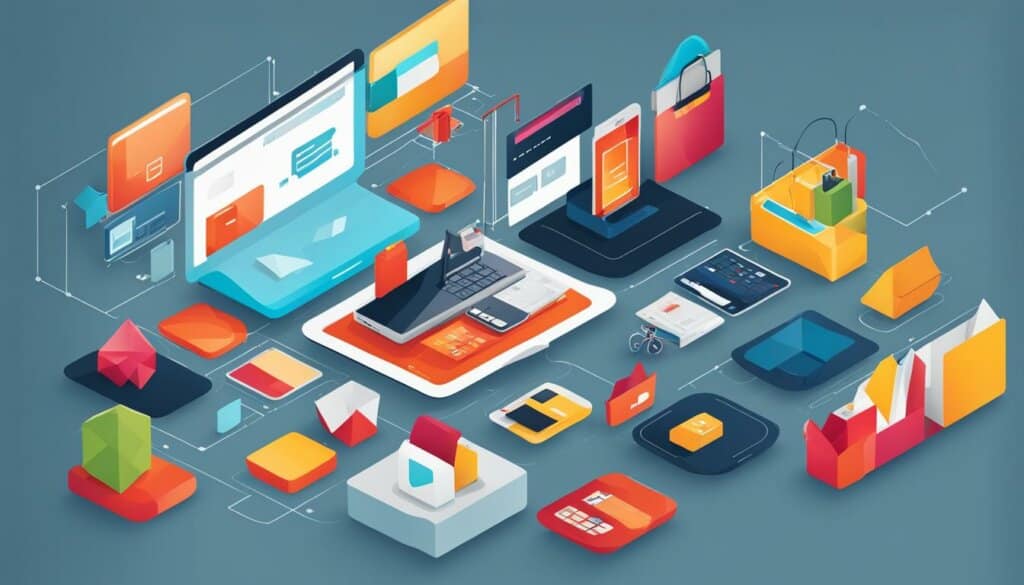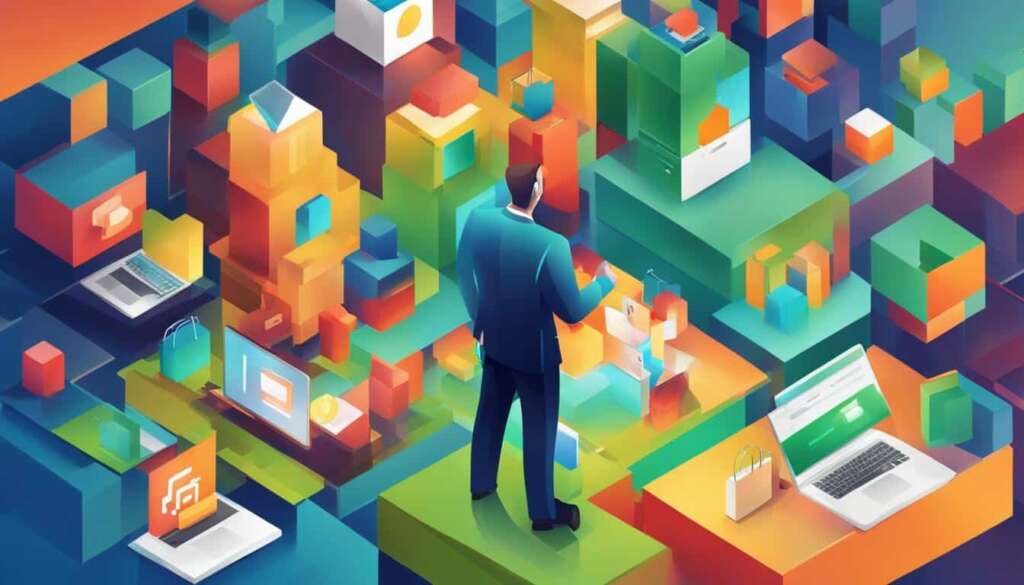Table of Contents
E-commerce, or electronic commerce, is a term that refers to the buying and selling of goods and services over the internet. It has become an integral part of online trading, revolutionizing the way business-to-business (B2B) and business-to-consumer (B2C) transactions are conducted. With the advancements in technology, e-commerce has gained immense popularity, providing a convenient platform for businesses and consumers alike.
E-commerce encompasses various types of transactions, including business-to-business (B2B), where businesses exchange products, services, or information with other businesses, and business-to-consumer (B2C), where businesses sell products or services directly to consumers. This online trading method has opened new avenues for businesses to expand their reach globally and tap into a wider customer base.
How Does E-commerce Work?
E-commerce relies on the internet as the primary medium for transactions. Customers access online stores through their own devices and browse through the products or services offered.
When an order is placed, the customer’s web browser communicates with the server hosting the e-commerce website. Data pertaining to the order is transmitted to the order manager, which then relays the information to various databases and systems that manage inventory, payment processing, and banking.
After the order is validated, the order manager notifies the customer and sends the order data to the warehouse or fulfillment department for shipment. This process applies to both tangible and digital products, as well as services.
| Key Components of E-commerce | Description |
|---|---|
| Internet | The internet serves as the platform for conducting e-commerce transactions. It allows customers to access online stores and interact with various systems and databases. |
| Online stores | These are websites or platforms where businesses showcase their products and services. Customers can browse, select, and purchase items online. |
| Web browser | A web browser is the software used by customers to access the internet and navigate online stores. It establishes a connection between the customer’s device and the e-commerce server. |
| Order manager | The order manager is a system that receives and processes customer orders. It relays order information to various departments and databases for inventory management, payment processing, and fulfillment. |
| Payment processing | This component enables customers to securely complete transactions by processing payments made through various methods such as credit cards, digital wallets, or online banking. |
| Warehouse | The warehouse is where physical products are stored and prepared for shipping. It receives order data from the order manager and works to efficiently fulfill customer orders. |
Whether customers are purchasing physical products or digital services, the process of e-commerce involves the seamless flow of data and information from the point of order placement to fulfillment.
Types of E-commerce
E-commerce encompasses various types of online transactions, catering to different parties involved. Here are the key categories of e-commerce:
- Business-to-business (B2B) e-commerce: This type of e-commerce focuses on transactions between businesses. It involves the exchange of products, services, or information exclusively among businesses. Online portals and exchange websites, such as Alibaba or Thomasnet, facilitate B2B transactions.
- Business-to-consumer (B2C) e-commerce: B2C e-commerce involves businesses selling products or services directly to consumers. This is the most prevalent form of e-commerce and encompasses popular platforms like Amazon or ASOS, where consumers can purchase a wide range of items.
- Direct-to-consumer (D2C) e-commerce: D2C e-commerce allows manufacturers or producers to sell their products directly to consumers, bypassing intermediaries or distributors. Notable D2C brands include Casper (mattresses) and Warby Parker (eyewear).
- Consumer-to-consumer (C2C) e-commerce: C2C e-commerce enables consumers to trade products, services, and information with each other through online platforms. Websites like eBay and Craigslist facilitate C2C transactions, providing a platform for individuals to buy and sell second-hand goods.
- Consumer-to-business (C2B) e-commerce: C2B e-commerce occurs when consumers make their products or services available online for companies to bid on and purchase. Platforms like Fiverr and Upwork allow individuals to offer their skills or expertise to businesses on a project basis.
- Business-to-administration (B2A) e-commerce: B2A e-commerce involves transactions between businesses and government bodies. This can include systems for online tax filing, procurement processes, or other administrative interactions.
- Consumer-to-administration (C2A) e-commerce: C2A e-commerce refers to transactions between consumers and government bodies. Examples include online payments for government services, filing tax returns electronically, or accessing health portals.
- Mobile commerce (m-commerce): M-commerce refers to online sales transactions conducted using mobile devices, such as smartphones or tablets. It encompasses a wide range of activities, including mobile banking, mobile shopping apps, and mobile payment systems like Apple Pay or Samsung Pay.
Understanding the different types of e-commerce is essential for businesses looking to establish their online presence and cater to specific market segments.
Key Points:
- E-commerce can be divided into various types based on the parties involved in the transactions.
- B2B e-commerce involves transactions between businesses, while B2C e-commerce focuses on businesses selling directly to consumers.
- D2C e-commerce allows manufacturers to sell products directly to consumers, bypassing intermediaries.
- C2C e-commerce enables consumers to trade products and services with each other.
- C2B e-commerce occurs when consumers offer their products or services to businesses for purchase.
- B2A and C2A e-commerce involve transactions between businesses or consumers and government bodies respectively.
- M-commerce refers to online sales transactions conducted using mobile devices.

Advantages and Disadvantages of E-commerce
E-commerce offers several advantages that have transformed the way businesses operate and customers shop. Let’s explore the benefits and drawbacks of this online trading platform.
Advantages of E-commerce
- 24/7 Availability: E-commerce allows businesses to be open around the clock, providing customers with the convenience of shopping whenever they want.
- Easy Accessibility: With just a few clicks, customers can access online stores from anywhere in the world using their smartphones, tablets, or computers.
- Wide Selection: E-commerce provides an extensive range of products and services, giving customers a diverse selection to choose from.
- International Reach: Through e-commerce, businesses can expand their customer base globally, reaching potential buyers from different corners of the world.
- Lower Operating Costs: Compared to physical stores, e-commerce offers cost advantages, including reduced rent, staffing, and inventory expenses.
- Personalization and Targeted Marketing: E-commerce platforms enable businesses to gather data about customers’ preferences, allowing for personalized recommendations and targeted marketing campaigns.
“E-commerce offers businesses the advantages of 24/7 availability, accessibility, wide selection, and international reach.”
Disadvantages of E-commerce
- Limited Customer Service: Unlike physical stores, e-commerce often offers limited customer service, with customers reliant on online support or FAQs.
- Lack of Physical Product Experience: With e-commerce, customers cannot physically touch or experience products before making a purchase decision, relying solely on product descriptions and images.
- Potential Wait Times for Shipping: Depending on the location and shipping method, customers may experience delays in receiving their ordered products.
- Security Issues: E-commerce transactions involve the exchange of sensitive information, making it crucial for businesses to implement robust security measures to protect customer data.
“However, e-commerce also has disadvantages, including limited customer service, lack of physical product experience, potential wait times for shipping, and security concerns.”
Despite the disadvantages, e-commerce continues to thrive, offering businesses opportunities for growth and innovation. By addressing challenges and providing a seamless and secure online shopping experience, businesses can leverage the advantages of e-commerce to reach a global audience and drive success.
| Advantages | Disadvantages |
|---|---|
| 24/7 availability | Limited customer service |
| Easy accessibility | Lack of physical product experience |
| Wide selection | Potential wait times for shipping |
| International reach | Security issues |
| Lower operating costs | |
| Personalization and targeted marketing |
With its advantages and disadvantages, e-commerce presents a dynamic landscape for businesses to navigate and explore. By capitalizing on the benefits, addressing the drawbacks, and continuously innovating, businesses can unlock the full potential of e-commerce in the digital era.
Conclusion
E-commerce has revolutionised the way businesses and consumers engage in commerce. It provides online businesses with a convenient and accessible platform to reach customers globally and generate revenue. The advantages of e-commerce are numerous, including the ability to overcome geographical limitations, reduce operating costs, and offer a personalised shopping experience.
By leveraging the internet, online businesses can expand their customer base and tap into new markets. E-commerce allows for 24/7 availability, ensuring that customers can shop at their convenience. Additionally, the wide selection of products and services available online caters to diverse consumer preferences. The international reach of e-commerce gives businesses the opportunity to establish a global presence, transcending borders and time zones.
However, it’s essential to acknowledge the challenges associated with e-commerce. Customer satisfaction remains a crucial factor, and businesses need to provide prompt and reliable customer service. Technical issues can arise, such as website maintenance or server downtime, which can disrupt the online shopping experience. Data security is also a concern, with businesses needing to implement robust security measures to protect customer information.
Despite these challenges, e-commerce continues to shape the modern business landscape, offering endless opportunities for growth and innovation. As technology advances and consumer behaviour evolves, online businesses must adapt and embrace the advantages of e-commerce while proactively addressing its disadvantages. By doing so, businesses can thrive in the dynamic world of digital commerce and deliver exceptional experiences to their customers.
FAQ
What is e-commerce?
E-commerce, also known as electronic commerce, refers to the buying and selling of goods and services over the internet.
How does e-commerce work?
When an order is placed on an e-commerce website, the customer’s web browser communicates with the server hosting the website to transmit order data. This information is then relayed to various databases and systems that manage inventory, payment processing, and banking. After the order is validated, the customer is notified, and the order is sent to the warehouse or fulfillment department for shipment.
What are the types of e-commerce?
E-commerce can be categorized into various types, including business-to-business (B2B), business-to-consumer (B2C), direct-to-consumer (D2C), consumer-to-consumer (C2C), consumer-to-business (C2B), business-to-administration (B2A), consumer-to-administration (C2A), and mobile commerce (m-commerce).
What are the advantages and disadvantages of e-commerce?
Some advantages of e-commerce include 24/7 availability, easy accessibility, a wide selection of products and services, and international reach. However, disadvantages include limited customer service, lack of physical product experience before purchase, potential wait times for shipping, and security issues.







